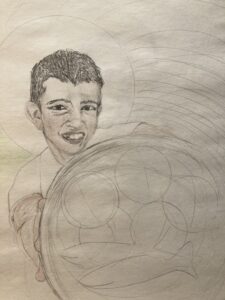
Before returning to New York to attend seminary, I had an artist studio. I was a sculptor in residence in a city center in Florida where I worked almost everyday. However, while in seminary, life became so busy that I didn’t have much opportunity to make art. But one day I carved out time to sit down with a sketch pad and draw. I had become fascinated with the story of “The Feeding of The 5000.”
I drew a fairly large picture of a young boy holding up a basket with five barley loaves and two fishes. I did some quick google research and found my “model,” an image of a Palestinian boy smiling up at the camera. The viewer of course (you and me) then becomes Jesus. In the complexity of this scene, we find a small boy; someone whom we might have missed. There is something special about staring into this child’s smiling face. It is an invitation to see through the eyes of Christ, to live into our full humanity as the image of God: God who we define as Love (see our catechism p. 849 of the Book of Common Prayer).
My original fascination with the feeding of the 5000 was a very intellectual investigation. I’m glad the artist side of my brain (and I suggest the praying side of my brain) was more embodied; less head and more heart. We learn from this small boy that there is joy in the abundance offered in a gift. Even a small gift can be abundantly received. The basket of fish and little cakes being lifted to Christ is a reminder of faith, of trust, of joy, of the importance of community and of course the Christian tenet that we remain “ever mindful of the needs of others.”
While this story is found in all four gospels, this passage is unique to John’s Gospel in several important ways: First, Jesus anticipates that the crowd will need to eat and to rest. Love is mindful of their needs. It also specifies that the bread being offered is made of barley. Bread made from barley was specific to the bread of the poor. Third: in this passage it is Jesus (rather than the disciples) who distributes the food personally. This gospel’s interpretation offers us a very intimate encounter with Jesus. Because the Gospel of John does not include a last supper narrative (as in Mark, Matthew and Luke) this scene can be interpreted as a last supper: Jesus personally feeding the multitudes of poor one person at a time.
The Gospel of John and this story focuses on the identity of Christ: the nature of God as Love revealed to us. The feeding of the 5000 helps us to see clearly what is possible in one small offering and through one small person when it is viewed through the abundant lens of Love.
Image: sketch, Heather K. Sisk
